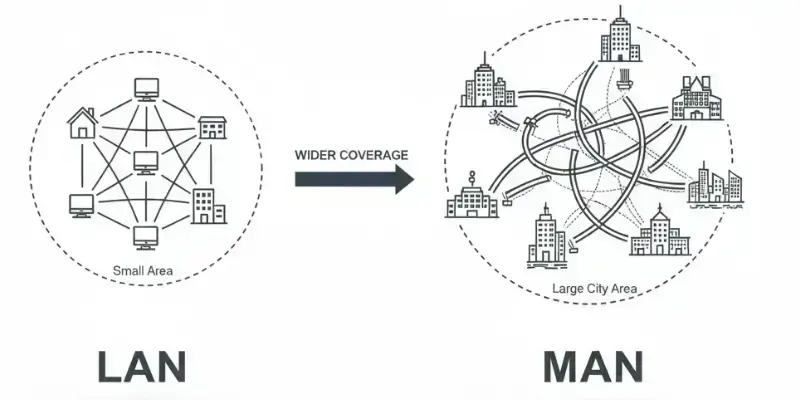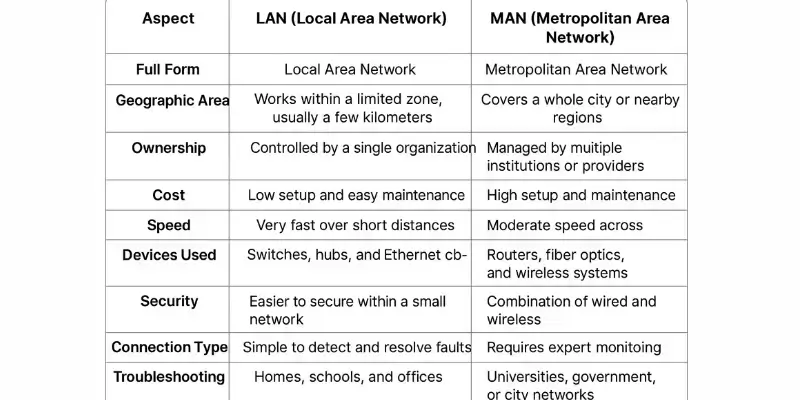LAN vs MAN Network: A Quick and Easy Comparison Guide
Published: October 20, 2025
When it comes to connecting computers and sharing data, two common types of networks often come up — LAN (Local Area Network) and MAN (Metropolitan Area Network). Both help link devices, but they work on very different scales. A LAN connects computers within a small area, such as a house, classroom, or small office. A MAN, in contrast, connects networks spread across a bigger area — like several offices, campuses, or even an entire town.
Many users want to know how these two networks differ and which one is a better fit for their setup. This post will outline their main features, uses, and advantages to help you make an informed choice.

Let’s determine which network best suits your needs.
Definition LAN vs MAN
LAN (Local Area Network)
A LAN (Local Area Network) connects computers and devices within a limited area, such as a single building or office. It allows users to easily share files, printers, and internet access. It’s ideal for homes, schools, and small businesses that need fast, local communication.
MAN (Metropolitan Area Network)
A man links multiple LANs across a larger geographic area, such as a city or a group of nearby locations. It helps organizations connect their different branches or campuses efficiently. It’s suitable for universities, government offices, or large companies with multiple sites.
Comparison Table: LAN vs MAN
| Aspect | LAN (Local Area Network) | MAN (Metropolitan Area Network) |
| 1. Full Form | Local Area Network | Metropolitan Area Network |
| 2. Geographic Area | Works within a limited zone, usually a few kilometers | Covers a whole city or nearby regions |
| 3. Ownership | Controlled by a single organization | Managed by multiple institutions or providers |
| 4. Cost | Low setup and easy maintenance | High setup and maintenance expenses |
| 5. Speed | Very fast over short distances | Moderate speed across larger areas |
| 6. Devices Used | Switches, hubs, and Ethernet cables | Routers, fiber optics, and wireless systems |
| 7. Security | Easier to secure within a small network | Needs advanced protection due to wider coverage |
| 8. Connection Type | Mostly wired (Ethernet) | Combination of wired and wireless |
| 9. Troubleshooting | Simple to detect and resolve faults | Requires expert monitoring and repair |
| 10. Common Use | Homes, schools, and offices | Universities, government, or city networks |
| 11. Primary Goal | Enables local sharing and communication | Connects several LANs for regional access |

Detailed Comparison: LAN vs MAN
1. Ease of Use
Compared to MAN, a LAN is simpler to set up and use, while MAN requires more expertise and effort due to its higher complexity.
LAN (Local Area Network)
LANs are simpler to install and manage than MANs, which are more complex.
Works well with minimal technical knowledge.
Ideal for small spaces, such as homes or schools.
MAN (Metropolitan Area Network)
A MAN, in contrast to a LAN, needs a professional setup and configuration.
Managing data across areas requires expertise.
Typically managed by IT pros or providers.
Compared to MANs, LANs are easier to handle for beginners or small setups.
2. Features
Here are the main functions of each network type.
LAN
LANs support file sharing, printing, and local communication, while MANs connect multiple networks over larger distances.
Offers high speed and reliability over short distances.
Easy to expand by adding more devices.
MAN
MAN connects multiple LANs for regional networking, whereas a LAN focuses solely on local area connections within a single location.
Handles bigger data transfers across distances.
Allows centralized control for multiple branches or offices.
LAN is best for local connections, while MAN is best for wider connections.
3. Performance
Performance depends on network range, speed, and connected systems.
LAN
Provides higher data transfer speeds compared to longer-distance connections.
Experiences minimal delay and better consistency.
Fewer users mean less traffic and faster response time.
MAN
Covers larger areas than competitors, so speed can be slightly reduced compared to others.
More users can slow speeds at times.
Still provides reliable connectivity across locations.
LAN offers faster, more consistent performance; MAN covers wider areas.
4. Pricing
Compare setup and maintenance costs.
LAN
LANs are more budget-friendly and require only basic equipment, while MANs are costlier due to their larger scale.
Maintenance costs are low.
Perfect for individuals or small offices.
MAN
Compared to LANs, MANs are more expensive due to their large-scale infrastructure requirements.
Requires expensive devices such as routers and fiber links.
Suited for big organizations and city-wide systems.
Choose LAN if you want a cost-effective option; MAN is suitable for large-scale needs.
5. Support
Support impacts network reliability and uptime.
LAN
LAN issues can be fixed quickly by local IT staff, unlike MANs, which need larger support teams.
Easier to troubleshoot due to small size.
MAN
MANs require a dedicated support team or service provider, whereas LANs are typically managed locally.
Repairs can take longer due to the larger coverage area.
LAN is easier to maintain; MAN requires professional expertise.
6. Security
Security matters when data spans locations.
LAN
LANs are easier to secure using local firewalls and permissions, while MANs require more complex security measures.
Fewer access points lower intrusion risk.
MAN
MANs are exposed to more threats than LANs due to their wider coverage.
Requires stronger encryption and monitoring.
LAN is easier to secure; MAN needs advanced security.
7. Scalability
How easily can each network be scaled?
LAN
LANs have limited expansion due to short range, while MANs are scalable over wide areas.
Works best within one location.
MAN
Can easily connect multiple LANs and new locations.
Handles growth across wide areas.
MAN is more flexible for expanding across sites.
Pros and Cons of LAN and MAN
When choosing a network, consider its strengths and limitations to inform your decision. LAN and MAN offer distinct features that can address different needs.
Pros of LAN (Local Area Network)
- High speed within small areas
- Easy to install and maintain
- Strong data security due to local control
- Affordable setup for homes or small offices
- Quick file and resource sharing
Cons of LAN
- Limited range (works only within a building or a small area)
- Needs wired connections in most cases
- Can slow down if too many users are connected
- Not ideal for connecting distant locations
Pros of MAN (Metropolitan Area Network)
- Covers large areas such as cities or campuses
- Connects multiple LANs for better communication
- Suitable for businesses, universities, or governments
- Supports both wired and wireless technologies
- Offers centralized network management
Cons of MAN
- High installation and maintenance costs
- Complex setup and troubleshooting
- Slower speed compared to LAN
- Requires advanced security measures
Similarities Between LAN and MAN
LAN and MAN share several common features, despite operating at different levels.
- Both connect computers and devices for data sharing, but LAN does so locally, while MAN does so on a city or regional scale.
- File transfer, internet access, and communication are supported across all networks.
- Both wired and wireless technologies can be used in these setups.
- Security measures, such as firewalls and encryption, keep data safe.
- Both boost teamwork and simplify management.
Final Verdict
In simple terms, both LAN and MAN provide fast, secure, and reliable data sharing; however, LAN serves smaller geographic areas, while MAN covers larger, city-wide regions.
After exploring the details, the question remains: which network should you choose?
Choosing between a LAN and a MAN depends on the size of your network.
If you want to connect multiple computers in one location—such as a home, school, or small office—a LAN is the smarter choice. It’s quick to set up, affordable, and easy to manage, offering fast speed, simple sharing, and strong security without high costs.
However, if your setup spans multiple locations such as different offices, campuses, or buildings across a city, then MAN is a better fit. It’s designed for large-scale use and helps connect multiple LANs under one system. It costs more but offers smooth communication across long distances.
As an expert, I’d say: use LAN for small, local networks and MAN for big, multi-site or city-wide connections, so you make the best choice for your needs.
Pick the one that matches your size, goals, and future plans, and you’ll never go wrong.
You may also like these posts:
Personal Area Network Security
What Is a Personal Area Network PAN
Metropolitan Area Network Topologies
Different Types of Metropolitan Area Network
FAQs About LAN vs MAN
A LAN connects devices within a small area, such as a home or office. A MAN links several LANs across a larger city or region.
Yes, it can. You can still share files, printers, and data between devices even without internet access
LAN is usually faster because it covers a smaller distance and has less signal loss. MAN can be slower since it connects multiple LANs across cities.
You’ll need switches, cables, and a router or hub. These connect computers, printers, and other local devices.
Yes, but it takes more work. You’ll need to connect multiple LANs using routers, fiber links, and proper network management.
This often occurs due to excessive user activity or large data transfers. Restarting the router or checking cables usually helps.
MANs are mostly handled by internet service providers or large IT teams. They have the tools and experience to manage wide networks.
Not always. MANs cover bigger areas, so they face more security risks — strong firewalls and encryption are a must.
A LAN is perfect for small offices or schools — simple, affordable, and easy to control. MAN works better for big organizations spread across multiple sites.
Verify that all routers and cables are functioning properly. If the issue persists, please contact your network provider for assistance.
Try our Organic SEO Services, Blog Writing Services or Write for Us





